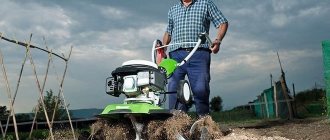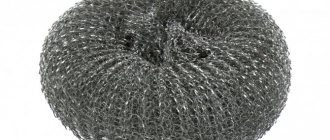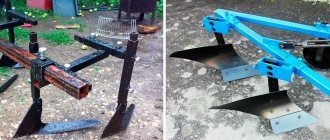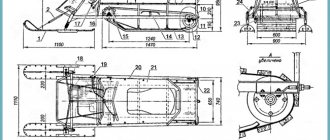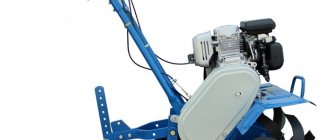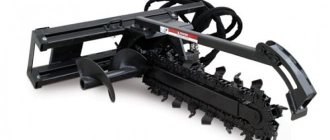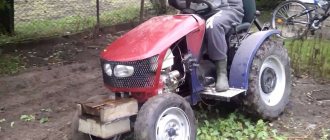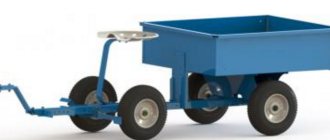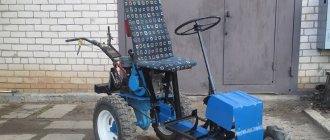In recent years, many land owners are increasingly using new technical developments that can make life much easier and spend much less time on certain tasks.
Walk-behind tractors, cultivators, mini-tractors and other devices have a tangible impact on the life of an agronomist. If traditional hoes were previously popular, which forced them to cultivate heavy soil in a half-bent state for several hours, today they have been replaced by innovative flat cutters designed for operation together with a walk-behind tractor.
Functions
The flat cutter for walk-behind tractors is very popular for a reason. Previously, gardeners used manual models, but when walk-behind tractors and attachments appeared, work in the garden became easier. Less effort was required and productivity increased.
Is used for:
- thinning plantings;
- hilling;
- weeding;
- ground leveling;
- deep loosening;
- preparing beds for planting;
- saturation of the soil with oxygen;
- crust destruction after rain;
- filling holes;
- inter-row processing.
The flat cutter does not turn over the soil, so it retains as much nutrients and moisture as possible.
At the same time, many gardeners note only one drawback: models of different sizes are required, because each crop has its own width between the rows.
You can easily buy a factory-made, branded flat cutter for a walk-behind tractor. But you can make it yourself, and the unit will turn out no worse.
Features of flat cutters of a walk-behind tractor
This device has the following operating principle:
- first, the knives carefully penetrate into the soil;
- then the walk-behind tractor begins to move, prune and thereby destroy the root systems of unwanted plants.
When this plant is already cut, it remains in the ground, rots there and subsequently becomes an excellent fertilizer for the soil.
A huge advantage of a walk-behind tractor is that when working in the ground, this device does not destroy or mix the upper crust of the earth, thus not only leaving the structure of the soil, but also improving it. Another plus is that the flat cutter prepares the ground for planting plant seeds and makes the necessary holes.
In this video we will look at a flat cutter for a walk-behind tractor:
Proper work
To work with a flat cutter as efficiently as possible, you should understand the basic principles of using attachments.
In general, there is nothing complicated about this. The algorithm of actions is as follows:
- If weeding and high-quality loosening are required, the blades of the flat cutter are directed to the left. So that they lie flat on the ground.
- If the weeds are thick, tall, or large thickets, then the blades also move to the left, but slightly lifting them above the ground.
- When arranging a bed, the blades point downwards. This will make the site neater.
- To form a backfill of seeds and rolls of soil, the blades are directed to the right and placed flat.
Even if you are a beginner farmer, these tips will help you achieve better results. And it will not depend on the type of flat cutter or the brand of the walk-behind tractor itself. Even with budget models you can achieve good results and get rid of weeds.
Store-bought or homemade
One of the main assistants for a gardener in the garden is a walk-behind tractor. It is with the help of it that you can easily do loosening, weeding, and plowing. But to expand the functionality of the unit, they use a flat cutter, which also helps get rid of weeds.
The answer to the question of whether to buy a flat cutter or make it yourself largely depends on whether you are willing to spend time and additional parts.
What kind of flat cutters for walk-behind tractors do you use?
PurchasedHomemade
What you need to pay attention to when making a flat cutter yourself:
- Material . It is best to take steel. It does not rust and lasts longer.
- Form . In any case, by omitting the parts, the flat cutter will resemble a comb.
If you decide to buy a flat cutter, then the main attention is paid to the price and model of your walk-behind tractor. Besides:
- immersion depth;
- tilt angle;
- material.
Types of cultivators
Let's look at the types of cultivators. The main parameters that you need to pay attention to are the weight of the mechanism and its power.
Heavy
Heavy mechanisms weigh up to 60 kg, and power reaches 6 hp. Such cultivators are equipped with their own engine, or are attached to a walk-behind tractor.
For more information about the operation of a heavy cultivator, watch the video:
Average
Medium mechanisms are the most common type in private households. Their weight is 45-60 kg, power is from 4 to 6 hp. The soil is cultivated to a depth of 25-28 cm.
Average
Lungs
Lightweight mechanisms – characterized by reduced weight (up to 40 kg). They cultivate the soil to a shallower depth - up to 18 cm.
Medium and light mechanisms can be assembled with your own hands using minimal technical knowledge.
DIY creation
If you don’t want to spend money on buying a flat cutter for a walk-behind tractor, you can make homemade equipment using available tools and parts.
To adapt the unit for various walk-behind tractors, just take the classic Fokin model:
- A piece of metal is heated on a blowtorch to create a blade.
- Sharpen for a knife using a grinding machine.
- They make holes to accommodate attachments.
- Determine the places that are bent by applying the product to the drawings.
- Using a blowtorch, shape the blades. An additional adjustable wrench can be used.
- Cool the blades in water.
- Then you can attach the unit to the walk-behind tractor and use it.
To prevent the plate from sinking too deeply into the ground, you need to make limiters. For this purpose, improvised materials are used, such as wheels from toy cars. The correct size is important. To ensure that the wheels last a long time, they are filled with metal bushings. This increases the level of resilience. The parts are installed at the bottom so that the tool does not sink deeper into the ground than five centimeters.
Expert opinion
Kulikov Vladimir Sergeevich
If there is no metal plate, then a section from a segment mower will do, but it should be divided into two parts. The segments should be secured, otherwise the finished product will “walk” and the farmer will experience discomfort before work.
In order for the tool to plunge without using much force, you need to weld a heavy element on top. And after the algorithm has been carried out, work on the coupling, which will connect it to the body of the unit. You should place a bearing on the inside of the axle with a plate on it, which will be the “base” for connecting to a homemade flat cutter.
From scrap metal
You can make a convenient flat cutter for a walk-behind tractor from an ordinary piece of scrap metal:
- Make a workpiece: opener 1 cm, height 40 cm, width 4 cm. Blades 3-4 mm thick, length 40 cm, width 4 cm.
- The unit is assembled and welded.
- To increase strength, corners can be strengthened.
- To secure a small harrow, bolts are welded along the edges.
- The harrow with teeth are connected by plates so that the teeth do not coincide with each other.
- Blades are sharpened and painted.
Models
There are several options for flat cutters. And each has its own advantages and features.
Mazneva "PM-4"
The most suitable and convenient design for loosening the ground. It has narrowed blades and modified fastenings, so you can change the distance between the fastenings of the knives up to 20 cm. This is convenient for processing different areas of the beds.
The handle is round, small, and has a “heel” to control the depth of penetration of the blades into the ground and the tilt of the unit. The flat cutter easily penetrates the garden bed, removes weeds and provides the soil with sufficient oxygen.
The only negative is that it does not work well when hilling the soil.
Fokina
This model has differences from Maznev:
- It copes worse with hard crusts and is weaker. Therefore, it is better to first dig up the bed with a shovel in local areas.
- Not suitable for thick, large, tall weeds. It is more effective to use a hoe.
- The loosening will not be of high quality, because the edge has sharp sides rather than blunt ones.
But if the site is additionally prepared with a hoe or shovel, then the Fokin flat cutter can be used.
Suitable for:
- loosening if the row spacing is more than 10 cm;
- cutting grass in a narrow space.
The most powerful of the Fokin line is the Moguschnik flat cutter.
It is shorter in length than standard models, but wider in width. Therefore, they can work on difficult soils and hill up potatoes. Moreover:
- preserves soil structure and fertile layer;
- creates conditions for beneficial microorganisms;
- does not put a lot of stress on the spine;
- saves time when working on site.
Petal
This flat cutter has two surfaces, which makes it look like a petal:
- straight;
- wedge-shaped.
Suitable for cutting weeds, forming furrows, weeding beds.
Pumpkin
The model is made of stainless steel, which is resistant to corrosion, and itself is lightweight and easy to sharpen. There are large and small types. Used for weeding, loosening and hilling. The advantage is that the top layer of soil is not damaged.
Hydra
Its working surface is rounded, and the end itself is powerful and sharp. It is used to form beds and hill up soil.
Drawing with dimensions
The drawing is made according to the dimensions of the original Fokin flat cutter. The more accurately the work is done according to the sample, the better quality tool you will receive.
Drawing with dimensions
Important! The Fokina flat cutter is protected by a patent. Mass production of replicas for sale is a violation of copyright. Single production for personal use is permitted.
Sharpening
Experienced gardeners understand that from time to time they should sharpen the flat cutter for the walk-behind tractor.
First, sharpening takes place on a machine, and then using a file or whetstone. It is done only on the outside, and the burrs are removed from the inside.
Expert opinion
Kulikov Vladimir Sergeevich
If the flat cutter was purchased and not made independently, then a machine is not required. The original flat cutter only needs sharpening from time to time.
A flat cutter that you created yourself can be used for heavy and light walk-behind tractors. It is suitable for Neva brand units and other foreign and domestic vehicles. The main thing is to follow certain rules when creating and using flat cutters.
Double-row hiller for walk-behind tractor
This type of hiller differs in content (equipment), appearance, power, and functions. A two-row attachment for a motor cultivator is better because it can help you hill up large areas of soil faster and less expensively, and you can also work with it in any weather and even with heavy soil.
It helps with clearing the area of weeds, leveling the soil or the bush of a cultivated plant, filling the black soil with a sufficient amount of moisture and oxygen, and preventing the sun’s rays from damaging the plant.

